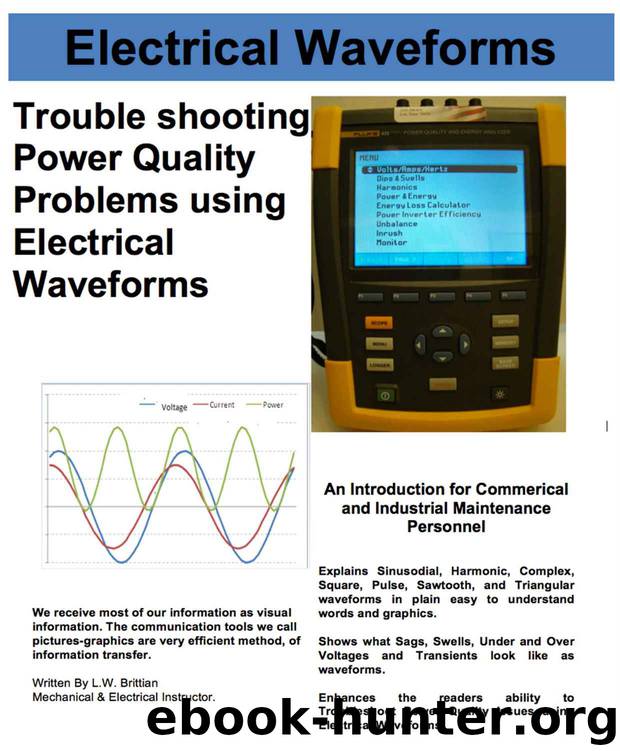Electrical Waveforms: Troubleshooting Power Quality Problems Using Electrical Waveforms by L. W. Brittian

Author:L. W. Brittian [Brittian, L. W.]
Language: eng
Format: azw3
Published: 2017-07-08T04:00:00+00:00
The reader should notice the steep (fast) rate of rise of the leading edge and the rate of decay of the trailing edge. The amount of potentially destructive energy applied to and then dissipated by the electrical system, can be visualized as the area under the waveform.
Oscillatory Transient
An oscillatory transient is a sudden change in the steady state condition, such as voltage or current. These changes can be either positive or negative or both in amplitude. Oscillatory transients typically decay to zero within a cycle and are known as decaying oscillations. These types of transients are produced when an inductor such as a transformer or motor, or some types of capacitive type load(s, such as power factor correction capacitor banks) are operated. An oscillatory transient can be a sudden rise at a frequency other than 60 HZ; above the steady state, condition (of either voltage or current) that swings (oscillates) in both the positive and the negative directions (polarity). These oscillations occur at a very high frequency.
Oscillatory transients with a dominate frequency that is less than 5 KHZ and last from 0.3 ms. to 50 ms. (miliseconds-1/1000 of one second) seconds are classified by IEEE as a low frequency transient. Low frequency oscillatory transients are associated with power factor correcting capacitor-switching operations by the electrical utility. Ok now did you make a note of that? Power factor correction capacitors are cut in and out of utility power distribution systems (and some large industrial power distribution systems) on a daily basis. Therefore, when you see this condition on a power monitor, you should know what it is by these variables.
An oscillatory transient with a dominate frequency of between 5 and 500 KHZ and a duration lasting in the tens of microseconds is classified as being a medium frequency transient. Medium frequency oscillatory transients are associated with back-to-back capacitor bank operation and cable (feeders) switching operations. This source of trouble can be eliminated by the use of a pre-charge circuit.
An oscillatory transient with a dominate frequency above 500 KHZ and a duration measured in microseconds, is considered to be a high frequency transient. The waveform below contains an oscillating transient type transient. Note that the waveform has both additive (positive) and subtractive (negative) regions of the deviations (spike-sag) from the steady state sinusoidal waveform.
Download
This site does not store any files on its server. We only index and link to content provided by other sites. Please contact the content providers to delete copyright contents if any and email us, we'll remove relevant links or contents immediately.
| Automotive | Engineering |
| Transportation |
Whiskies Galore by Ian Buxton(41940)
Introduction to Aircraft Design (Cambridge Aerospace Series) by John P. Fielding(33093)
Small Unmanned Fixed-wing Aircraft Design by Andrew J. Keane Andras Sobester James P. Scanlan & András Sóbester & James P. Scanlan(32764)
Craft Beer for the Homebrewer by Michael Agnew(18198)
Turbulence by E. J. Noyes(7980)
The Complete Stick Figure Physics Tutorials by Allen Sarah(7338)
Kaplan MCAT General Chemistry Review by Kaplan(6900)
The Thirst by Nesbo Jo(6881)
Bad Blood by John Carreyrou(6583)
Modelling of Convective Heat and Mass Transfer in Rotating Flows by Igor V. Shevchuk(6406)
Learning SQL by Alan Beaulieu(6237)
Weapons of Math Destruction by Cathy O'Neil(6218)
Man-made Catastrophes and Risk Information Concealment by Dmitry Chernov & Didier Sornette(5957)
Digital Minimalism by Cal Newport;(5704)
Life 3.0: Being Human in the Age of Artificial Intelligence by Tegmark Max(5516)
iGen by Jean M. Twenge(5385)
Secrets of Antigravity Propulsion: Tesla, UFOs, and Classified Aerospace Technology by Ph.D. Paul A. Laviolette(5333)
Design of Trajectory Optimization Approach for Space Maneuver Vehicle Skip Entry Problems by Runqi Chai & Al Savvaris & Antonios Tsourdos & Senchun Chai(5037)
Pale Blue Dot by Carl Sagan(4956)
